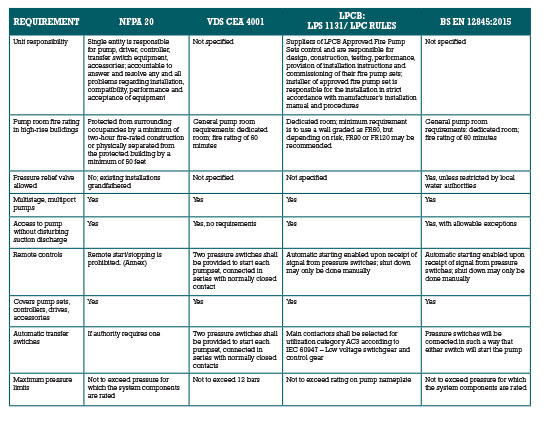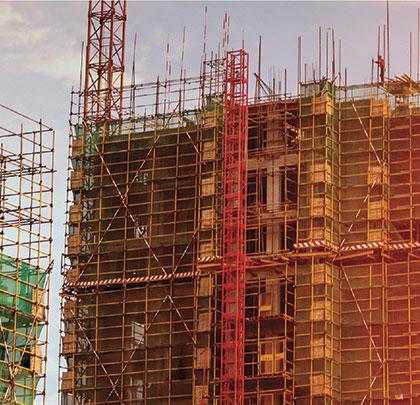As we introduced in part 1 of this article last month, the fire pump is one of the most critical pieces of equipment for the fire protection system, and the development of codified performance-based approaches to system design has begun to present designers with a better assessment of risk. Standards governing fire pumps are most often included in broader guidelines for automatic sprinkler systems as the fire pump is a crucial part of the overall system. Some standards are loose guidelines for further code development; others that are more detailed and complex are designed to account for all conceivable scenarios in order to ensure maximum protection. Here is a summary of the leading standards and how they are applied:
NFPA 20
The Standard for the Installation of Stationary Pumps for Fire Protection is the most widely recognized standard in the world, issued by the U.S.-based National Fire Protection Agency and prepared by NFPA’s Technical Committee on Fire Pumps. The committee consists of more than two dozen members and nearly two dozen alternates representing fire departments, fire equipment manufacturers, listing authorities, government, academia, engineering, insurers, associations, unions, and other groups.
NFPA 20 is considered the most stringent of all the leading codes with its many redundancies and safety measures. Unlike other standards, NFPA 20 addresses the entire fire pump room—the pump, driver, controller, as well as water and fuel supplies, valves and other ancillary equipment necessary—to ensure each of the individual components will perform as a whole if the system is activated. This is a critical distinction between NFPA 20 and other standards, which might simply require UL and FM (or similar) certified components and not take into account if those components will function properly together. (UL and FM certifications are fully compliant to NFPA 20.) In addition, NFPA 20 requires a single entity bear responsibility for all of the components in regard to installation, compatibility, performance and acceptance of equipment. FM specifies this be the pump manufacturer; UL does not specify the entity.
NFPA standards are implemented internationally, advancing the development of standards for fire and life safety in many countries. Section 913 of the International Fire Code addresses the protection of the fire pump room within the building and defers to NFPA 20 for the installation and testing of fire pumps. In addition, NFPA has agreements called Memorandums of Understanding with standards-setting groups in more than a dozen countries, most recently adding the UAE in 2016. The primary purpose of each MOU is to promote the adoption of NFPA standards.

BS EN 12845
In Europe, BS EN 12845 offers best-practice recommendations for the design, installation and maintenance of automatic sprinkler systems, and includes fire pumps. It is derived from EN 12845, developed by the European Committee for Standardization, known as CEN, which works with the standardization bodies of 33 European countries. The first EN (European Norm) sprinkler installation standard was issued in 2004 and revised in 2009 and 2015. Prior to that time, insurance companies in individual countries shaped fire protection rules. As countries add their own standards to the nonbinding EN 12845, the country standards supersede the EN code.
British Standard (BS) is the United Kingdom implementation of EN 12845 and covers classification, routine testing, design, maintenance, water supply, extension, installation, and special hazards related to sprinklers.
The UK-based Fire Protection Association has developed Loss Prevention Council (LPC) Rules for Automatic Sprinkler Installation, which incorporates and supplements BS EN 12845. Changes in the 2015 edition related to fire pumps include greater specification on electric pump power supplies and pump curve stability. EN 12845 eliminates the requirement for stable pump curve with steadily declining head, but LPC has deemed this an important requirement and retained it in its 2015 standards.
It’s important to note that while fire pumps are included in these standards, the BS EN 12845 is not a pump standard and lacks the detail of NFPA 20, and also differs from LPCB, mentioned below.

CEA 4001
The CEA is the European insurance and reinsurance federation. The CEA 4001 standard specifies requirements and recommendations for the design, installation and maintenance of fixed fire sprinkler systems in buildings and includes a chapter on pumps. CEA 4001 is based on EN 12845, with some updates and additional requirements.
VdS, owned by the German Insurance Association, uses CEA 4001 as the basis for its standards relating to the planning and installation of sprinkler systems, known as VdS CEA 4001. The standard covers pumps, drives, and controllers, but not as comprehensively as the NFPA 20 standard as it focuses on the individual components, and not the ethicacy of the system.
LPCB
Unlike BS EN 12845 and CEA 4001, the Loss Prevention Control Board (LPCB) issues a standard specifically for centrifugal pumps used in pump sets in automatic sprinkler installations. The LPCB is the certification arm of BRE Global Ltd., based in the United Kingdom. It incorporates Loss Prevention Standards (LPS) for automatic sprinklers, BS EN 12845, LPC sprinkler rules and technical bulletins in its LPS 1131: Requirements and testing methods for pumps for automatic sprinkler installation pump sets.
Included in LPS 1131 are definitions of the types of centrifugal pumps covered in the standard, however, it does not include requirements for the pump set driver or controller, a critical distinction between this standard and NFPA 20.
THIRD-PARTY CERTIFICATIONS
An important function of LPCB and VdS is to conduct third-party testing and certification internationally to ensure that components, equipment, systems and services comply with the standards for fire protection. In its testing, VdS Inspection Services also includes other standards, such as those produced by NFPA and FM. In its evaluation of products, LPCB considers the manufacturer’s specifications for performance and construction. Once a product, service or company is certified by LPCB, it is listed in the Red Book, a resource for system designers and others involved in fire protection.
Installers who receive third-party certification ensure that standards are met in designing and installing sprinkler systems for fire protection. Third-party certification is valuable for manufacturers because it demonstrates their products conform to recognized safety standards, reducing liability. In addition, system designers who specify certified products have confidence the products will perform in accordance with their stated specifications and intended purpose.

CONCLUSION
By 2030, the world is projected to have 41 mega cities with more than 10 million inhabitants. Most of those places today are medium-sized cities and cities with less than one million people. Rapid urbanization will pose opportunities and challenges in every segment of society—socially, politically, environmentally, economically—including the built environment.
Speaking at a 2016 symposium in the UAE, NFPA President and CEO Jim Pauley summed up the future of fire service with these remarks: “There are new challenges, new technologies and new threats that warrant new thinking and new approaches. The once unimaginable … is real, with real impact on fire and life safety.” ◆
Brian Buscher is a global marketing manager for Xylem’s A-C Fire brand with expertise in centrifugal pump systems for fire suppression in industrial and commercial facilities. He is a principal member of the NFPA 20 Technical Committee on Fire Pumps. Buscher holds a bachelor’s degree from Northeastern Illinois University. Any comments/opinions made are the author’s own and not those of NFPA. For more information, visit www.xylem.com.
____________________________________________
MODERN PUMPING TODAY, April 2017
Did you enjoy this article?
Subscribe to the FREE Digital Edition of Modern Pumping Today Magazine!
![]()


